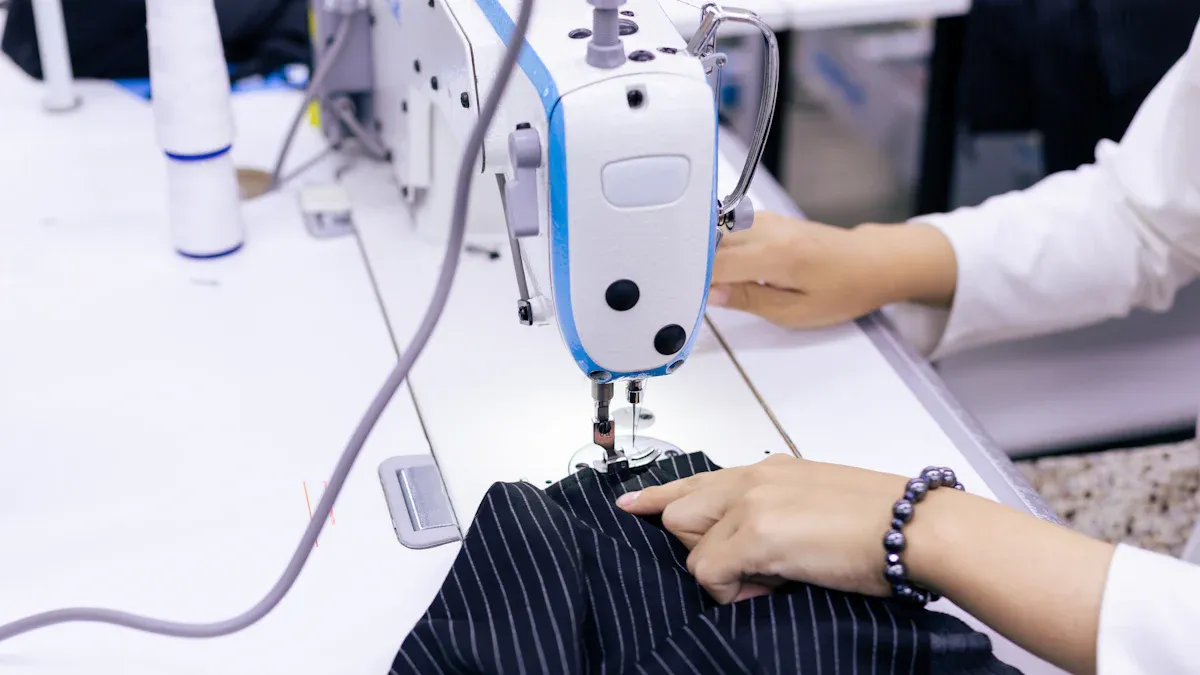
Trouver le bon fabricant de maillots de bain est essentiel pour construire une marque réussie. Vous avez besoin d'un partenaire qui garantit une qualité constante et aide vos produits à se démarquer dans un marché concurrentiel. Avec l'industrie du maillot de bainDevrait passer de 25 963,63 millions USD en 2024 à 38 371,77 millions USD d'ici 2032Les enjeux sont élevés. Les marques qui donnent la priorité à la fiabilité et à l'innovation dans la fabrication gagnent un avantage, d'autant plus que les consommateurs exigentMatériaux écologiques et conceptions avancées. Un fabricant fiable s'assure que vos clients reçoivent des maillots de bain qui correspondent à leurs attentes, améliorant la satisfaction et la fidélité.
À emporter clés
Choisissez un fabricant de maillots de bain digne de confiance pour renforcer l'image de votre marque. Les bons produits gagnent la confiance des clients et conduisent à des références.
Vérifiez l'expérience du fabricant et combien ils peuvent produire. Les fabricants qualifiés travaillent bien et s'adaptent aux changements du marché.
Concentrez-vous sur des matériaux solides pour un maillot de bain durable et de qualité. Les bons tissus rendent les clients heureux et correspondent à la qualité de votre marque.
Renseignez-vous sur les choix de conception et combien de temps les commandes prennent. Les conceptions personnalisées aident votre marque à briller et à répondre aux besoins des clients.
Examinez attentivement les fabricants et demandez des échantillons. Les échantillons de test s'assure que le produit est juste avant de faire beaucoup.
Pourquoi un fabricant de maillots de bain fiable est crucial
Impact sur la réputation de la marque
La réputation de votre marque dépend fortement de la qualité de vos produits. AFabricant fiable de maillots de bainGarantit que vos maillots de bain répondent à des normes élevées, ce qui influence directement la façon dont les clients perçoivent votre marque. Lorsque vos produits sont constamment de qualité, les clients font confiance à votre marque et sont plus susceptibles de la recommander à d'autres.
Des marques comme TYR Sport et Arena démontrent comment les partenariats de fabrication peuvent façonner la réputation. TYR Sport collabore avec une usine qui privilégie le contrôle qualitéS'assurer que leurs maillots de bain répondent aux attentes de performance. Arena, d'autre part,Travaille avec un fabricant connu pour son innovationRésultant en maillots de bain avancés avec des caractéristiques comme les revêtements hydrofuges. Ces partenariats ont aidé les deux marques à établir la confiance et à maintenir un avantage concurrentiel sur le marché.
Assurer une qualité constante
La cohérence de la qualité est essentielle pour la satisfaction et la fidélité des clients. Un fabricant de maillots de bain fiable utilise des processus de contrôle de qualité stricts pour s'assurer que chaque produit répond aux mêmes normes élevées. Cette cohérence réduit les plaintes des clients et améliore la satisfaction.
Par exemple, les données montrent queRéduire les plaintes des clients jusqu'à 25% et atteindre un taux de satisfaction de 95%Peut augmenter considérablement la loyauté. Des sondages réguliers et les commentaires des consommateurs aident les fabricants à affiner les conceptions et à aligner les produits sur les demandes du marché. En maintenant une qualité constante, vous pouvez renforcer votre relation avec les clients et encourager les achats répétés.
Métrique | Impact sur la fidélisation des clients |
|---|---|
Réduction des plaintes des clients | Jusqu'à 25% |
Taux cible de satisfaction client | 95% |
Répondre aux attentes des clients
Les clients attendent un maillot de bain qui va bien, dure longtemps et fonctionne comme promis. Un fabricant de maillots de bain fiable vous aide à répondre à ces attentes en utilisant des matériaux de haute qualité et des techniques de production avancées. Lorsque les clients reçoivent des produits qui correspondent à leurs attentes, ils se sentent satisfaits et sont plus susceptibles de revenir.
Dans un marché concurrentiel, répondre aux attentes des clients n'est pas seulement une question de qualité, mais aussi d'innovation. Les fabricants qui restent à jour avec les tendances du marché et les préférences des consommateurs peuvent vous aider à créer des maillots de bain qui se démarquent. Cette approche garantit que votre marque reste pertinente et attrayante pour votre public cible.
Facteurs clés à évaluer dans un fabricant de maillots de bain

Choisir le bon fabricant de maillots de bain implique d'évaluer plusieurs facteurs critiques. Ces facteurs garantissent que votre marque offre des produits de haute qualité qui répondent aux attentes des clients et se démarquent sur le marché. Voici les principaux aspects que vous devriez considérer.
Expérience dans la production de maillots de bain
Un fabricant avec une vaste expérience dans la production de maillots de bain apporte une expertise précieuse à votre marque. Des années de pratique leur permettent d'affiner leurs processus, assurant efficacité et qualité. Les fabricants expérimentés comprennent les défis uniques de la production de maillots de bain, tels que la création de tissus durables, extensibles et résistants au chlore. Ils restent également à jour sur les tendances de l'industrie, vous aidant à concevoir des produits qui plaisent aux consommateurs modernes.
Par exemple, les fabricants ayant fait leurs preuves ont souvent établi des relations avec des fournisseurs fiables. Cela garantit l'accès à des matériaux de haute qualité et réduit le risque de retards de production. En vous associant à un fabricant expérimenté, vous gagnez un avantage concurrentiel et minimisez les revers potentiels.
Qualité des matériaux et normes
Les matériaux utilisés dans les maillots de bain ont un impact significatif sur sa durabilité, son confort et ses performances. Les tissus de haute qualité, tels que les mélanges de nylon ou le polyester recyclé, garantissent que vos produits résistent à l'usure tout en conservant leur forme et leur couleur. Un fabricant de bonne réputation adhère à des normes de qualité strictes, en effectuant des contrôles approfondis à chaque étape de la production.
Pour comprendre l'importance de la qualité des matériaux, considérez le tableau suivant, qui met en évidenceFacteurs d'évaluation clés dans la fabrication de maillots de bain:
Facteur d'évaluation | Description |
|---|---|
Criticité des intrants | Importance des matières premières et des intrants de production dans la fabrication de maillots de bain. |
Cycle de vie | Examen des étapes du cycle de vie du produit pertinentes pour les maillots de bain. |
Facteurs de différenciation | Caractéristiques uniques qui distinguent les marques de maillots de bain sur le marché. |
Critères d'achat | Les facteurs clés qui influencent les décisions des consommateurs lors de l'achat de maillots de bain. |
En privilégiant la qualité des matériaux, vous vous assurez que votre maillot de bain répond aux attentes des clients et s'aligne sur la réputation d'excellence de votre marque.
Flexibilité de la personnalisation et de la conception
Les options de personnalisation permettent à votre marque de créer des maillots de bain uniques qui reflètent son identité. Un fabricant offrant une flexibilité de conception peut répondre à vos besoins spécifiques, des choix de tissus aux motifs complexes. Cette capacité est essentielle pour les marques qui cherchent à se différencier sur un marché encombré.
Les fabricants dotés d'outils de conception avancés et d'équipes qualifiées peuvent donner vie à votre vision. Ils peuvent également s'adapter aux tendances changeantes, en veillant à ce que vos produits restent pertinents. Par exemple, si vous souhaitez introduire des maillots de bain écologiques, un fabricant flexible peut se procurer des matériaux durables et ajuster les méthodes de production en conséquence.
Astuce:Lorsque vous discutez des options de personnalisation, renseignez-vous sur les quantités minimales de commande et les délais. Cela vous aide à planifier votre inventaire et à éviter la surproduction.
Capacité de production et évolutivité
Comprendre la capacité de production d'un fabricant est essentiel pour s'assurer que votre marque peut répondre à la demande des clients. Un fabricant de maillots de bain avec des opérations évolutives peut se développer aux côtés de votre entreprise, vous aidant à éviter les ruptions de stock ou les retards. L'évaluation de la capacité de production implique l'évaluation de plusieurs facteurs clés qui influencent la capacité d'un fabricant à livrer à temps.
Sortie par unité de tempsCette métrique indique le nombre d'unités qu'un fabricant peut produire dans un délai spécifique. Il vous aide à déterminer s'ils peuvent gérer vos volumes de commandes actuels et futurs.
Affectation des ressourcesL'utilisation efficace des ressources, telles que les matériaux et la main-d 'œuvre, assure des processus de production fluides. Les fabricants ayant une allocation de ressources bien planifiée peuvent mettre à l'échelle leurs opérations sans compromettre la qualité.
Efficacité de productionUne efficacité élevée réduit les déchets et maximise la production, permettant aux fabricants de respecter des délais serrés.
Compétences de la main-d 'œuvre et qualité de l'équipementLes travailleurs qualifiés et les machines avancées jouent un rôle important dans le maintien de niveaux de production constants.
Lorsque vous discutez de l'évolutivité, demandez au fabricant ses stratégies pour gérer la demande accrue. Ont-ils des plans d'urgence pour les pics d'ordre soudains? Peuvent-ils augmenter leur effectif ou mettre à niveau l'équipement si nécessaire? Ces questions vous aident à évaluer leur capacité à soutenir la croissance de votre marque.
AstuceChoisissez un fabricant ayant fait ses preuves en matière de mise à l'échelle de la production. Cela garantit que votre marque peut s'adapter aux tendances du marché et aux fluctuations saisonnières de la demande.
Tarification et gestion des coûts
La gestion efficace des coûts est cruciale pour maintenir la rentabilité tout en livrant des maillots de bain de haute qualité. Un fabricant de maillots de bain fiable offre des prix transparents et vous aide à identifier les opportunités de réduction des coûts sans sacrifier la qualité. Pour évaluer les stratégies de gestion des coûts d'un fabricant, tenez compte des aspects suivants:
Aspect | Détails |
|---|---|
Comprendre les tendances de prix et les facteurs de conduite des coûts dans la production de maillots de bain. | |
Structure des coûts | Analyser les intrants et le coût total de possession, y compris les matériaux et la main-d 'œuvre. |
Possibilités d'économie de coûts | Cherchez des moyens de réduire les coûts, tels que l'achat en vrac ou l'optimisation des conceptions. |
Pratiques exemplaires en matière d'approvisionnement | Apprenez des stratégies de gestion des risques et d'excellence en approvisionnement. |
Lorsque vous discutez des prix, demandez une ventilation détaillée des coûts. Cela vous aide à identifier les domaines dans lesquels vous pouvez négocier ou optimiser vos dépenses. Par exemple, certains fabricants offrent des rabais pour des commandes plus importantes ou des partenariats à long terme. De plus, renseignez-vous sur leur approche pour minimiser les déchets et améliorer l'efficacité, car ces facteurs peuvent avoir un impact significatif sur les coûts.
RemarqueBien que le coût soit important, évitez de choisir un fabricant uniquement en fonction du prix le plus bas. Prioriser le rapport qualité-prix en équilibrant les coûts avec la qualité et la fiabilité.
Communication et réactivité
Une communication efficace est la base d'un partenariat réussi avec votre fabricant de maillots de bain. Un fabricant réactif vous tient informé tout au long du processus de production, assurant transparence et confiance. Pour évaluer leurs compétences en communication, tenez compte des points de repère suivants:
Délai de réponse initial d'enquêteÀ quelle vitesse le fabricant répond-il à votre premier contact? Une réponse rapide indique le professionnalisme et la fiabilité.
Clarté et détailFournissent-ils des réponses claires et détaillées à vos questions? Cela montre leur volonté de collaborer et de partager des informations.
Mises à jour proactivesLe fabricant vous tient-il informé de l'avancement de la production sans avoir besoin de rappels? Des mises à jour régulières vous aident à rester sur la bonne voie et à résoudre rapidement les problèmes potentiels.
Lors de l'évaluation d'un fabricant, faites attention à la façon dont ils traitent vos demandes. Sont-ils à l'écoute de vos préoccupations et proposent-ils des solutions? Sont-ils ouverts à la rétroaction et prêts à faire des ajustements? Une communication solide assure un processus de production fluide et vous aide à construire un partenariat à long terme.
AstuceTester la réactivité d'un fabricant en envoyant quelques demandes initiales. Leur temps de réponse et la qualité de la communication peuvent révéler beaucoup sur leur professionnalisme.
Pratiques éthiques et durables dans la fabrication de maillots de bain

L'importance de la durabilité dans les maillots de bain
La durabilité est devenue un objectif clé dans l'industrie du maillot de bain. Les consommateurs préfèrent désormais les marques qui privilégient les pratiques écologiques. Les maillots de bain durables réduisent non seulement les dommages environnementaux, mais font également appel à un marché en croissance. Le marché du maillot de bain durable devrait atteindre16,2 milliards de dollars d'ici 2032. Cette croissance met en évidence la demande croissante de produits fabriqués avec soin pour la planète.
Les maillots de bain durables utilisent souvent des matériaux durables. Ces matériaux réduisent le besoin de remplacements fréquents, ce qui aide à minimiser les déchets. En choisissant un fabricant engagé envers la durabilité, vous alignez votre marque sur ces valeurs. Cette approche renforce votre réputation et attire des clients soucieux de l'environnement.
Matériaux et procédés écologiques
Les matériaux et procédés écologiques jouent un rôle essentiel dans la réduction de l'impact environnemental de la production de maillots de bain. De nombreuses marques utilisent maintenantEn polyester recyclé fabriqué à partir de déchets plastiques post-consommation. Ce matériau préserve les ressources et réduit la pollution. ECONYL®, Un tissu fabriqué à partir de plastiques océaniques recyclés, est un autre choix populaire. Il favorise la responsabilité environnementale tout en maintenant des performances élevées.
Certains fabricants adoptent des techniques de production à faible teneur en eau. Ces méthodes permettent d'économiser l'eau et de minimiser les déchets. Le coton biologique, cultivé sans pesticides nocifs, favorise la santé des sols et la biodiversité. La conception en fin de vie est une autre innovation. Il garantit que les produits sont faciles à recycler ou à biodégrader, réduisant ainsi leur empreinte environnementale.
AstuceLors de l'évaluation des fabricants, renseignez-vous sur leur utilisation de matériaux recyclés et de techniques d'économie d'eau. Ces pratiques démontrent leur engagement envers la durabilité.
Pratiques de travail équitables et normes éthiques
Des pratiques de travail éthiques sont essentielles pour la fabrication durable de maillots de bain. Certifications comme GOTS, OEKO-TEX®Et commerce équitableIndiquent l'engagement du fabricant à traiter équitablement les travailleurs. Ces certifications garantissent des conditions de travail sûres et des salaires équitables.
Les initiatives d'engagement communautaire reflètent également des valeurs éthiques. Les fabricants qui soutiennent les communautés locales contribuent au développement social et économique à long terme. En vous associant à de tels fabricants, vous vous assurez que votre marque respecte des normes éthiques élevées. Cet engagement renforce la confiance avec vos clients et renforce votre identité de marque.
RemarqueRechercher des fabricants avec des certifications reconnues. Ces certifications garantissent des pratiques éthiques et durables dans leurs opérations.
Étapes pratiques pour trouver le bon fabricant de maillots de bain
Mener des recherches en ligne
La recherche en ligne est une première étape cruciale pour trouver un fabricant de maillots de bain fiable. Commencez par explorer les plates-formes qui répertorient les fabricants réputés. Sites Web commeApprovisionnement sans couture, AliExpress, et ChinabrandsFournir des profils détaillés et des examens des fournisseurs de maillots de bain. Ces plateformes vous aident à comparer les options et à identifier les fabricants qui correspondent aux besoins de votre marque.
Plateforme | Description |
|---|---|
Approvisionnement sans couture | Répertorie les meilleurs fabricants de maillots de bain, offrant un point de départ fiable pour votre recherche. |
Aliexpress | Une plateforme de confiance pour trouver des fournisseurs de maillots de bain en Chine, facilitant les transactions mondiales. |
Avis sur Chinabrands | Offre un large éventail de fabricants avec des profils et des critiques, assurant la fiabilité. |
Lorsque vous effectuez des recherches, concentrez-vous sur les fabricants ayant des critiques positives et des antécédents éprouvés. Recherchez des détails sur leurs capacités de production, la qualité des matériaux et les options de personnalisation. Cette approche vous assure de sélectionner des fabricants qui répondent à vos exigences.
Demande d'échantillons et de prototypes
La demande d'échantillons est essentielle pour évaluer la qualité et la fiabilité d'un fabricant. Les échantillons vous permettent d'évaluer les matériaux, les coutures et le savoir-faire général du maillot de bain. Les fabricants qui fournissent des prototypes démontrent leur engagement à répondre à vos attentes avant le début de la production de masse.
Utilisez des méthodes statistiques telles que la détermination de la taille de l'échantillon pour vous assurer que les prototypes représentent la qualité du produit final. Les tests T peuvent également aider à comparer plusieurs itérations de conception et à valider les mesures de performance. Par exemple:
Les tests T évaluent des facteurs tels que la durabilité et l'élasticité du tissu.
Des évaluations basées sur les données garantissent que le produit final répond aux normes de votre marque.
En testant des prototypes, vous minimisez les risques et prenez des décisions éclairées concernant votre partenaire de fabrication.
Examen des témoignages et des études de cas
Les témoignages et les études de cas fournissent des informations précieuses sur la performance d'un fabricant. Recherchez des critiques d'autres marques qui mettent en valeur leurs expériences. Les témoignages positifs mentionnent souvent une livraison rapide, une qualité constante et un excellent service client.
Étude de cas | Description |
|---|---|
Retournement remarquable des ventes | La société A a doublé ses ventes en six mois en s'associant à un fabricant qualifié. |
La satisfaction des clients est en hausse | L'entreprise B a amélioré la satisfaction des clients grâce à une collaboration efficace. |
Par exemple, un témoignage pourrait indiquer: «Nos revenus ont augmenté de manière significative après le partenariat avec ce fabricant. Leur souci du détail et leur contrôle de la qualité ont dépassé nos attentes." Ces commentaires vous aident à évaluer la fiabilité et la pertinence du fabricant pour votre marque.
AstucePrivilégiez les fabricants avec une histoire de partenariats réussis. Leur expérience éprouvée réduit la probabilité de problèmes de production.
Visiter les installations de fabrication
Visiter les installations d'un fabricant vous donne une compréhension claire de leurs opérations et des normes de qualité. Observer le processus de production en personne vous permet d'évaluer leur efficacité, leur équipement et leurs conditions de travail. Cette étape garantit que le fabricant s'aligne sur les attentes et les valeurs de votre marque.
Lors de votre visite, concentrez-vous surIndicateurs clés qui reflètent le rendement de l'installation. Ces mesures fournissent des informations précieuses sur leurs processus de fabrication et leurs mesures de contrôle de la qualité. Le tableau ci-dessous met en évidence certains aspects importants à évaluer:
Métrique | Description |
|---|---|
Efficacité de synchronisation interne | Mesure l'efficacité du fonctionnement de l'installation, y compris les temps de cycle. |
Taux d'utilisation de la capacité | Indique le pourcentage de la capacité de production totale utilisé. |
Réalisation du calendrier | Permet de suivre la fréquence à laquelle les objectifs de production sont atteints, reflétant l'utilisation des ressources et l'efficacité. |
Métriques d'audit | Surveille la conformité et l'efficacité des processus, y compris les taux de non-conformité. |
Métriques de maintenance | Surveille la fiabilité de l'équipement et les activités d'entretien, assurant une qualité constante. |
Rendement | Affiche le rapport de la production à l'entrée, en soulignant l'efficacité et la qualité de la production. |
Efficacité globale de l'équipement | Combine disponibilité, performance et qualité pour mesurer la performance des équipements. |
Débit | Reflète la quantité de produit produite dans un temps donné, indiquant l'efficacité de production. |
Métriques de la qualité des fournisseurs | Évalue la qualité des matériaux reçus des fournisseurs, ce qui a une incidence sur le produit final. |
Métriques de livraison | Mesure l'exactitude et la ponctualité des livraisons, affectant la satisfaction du client. |
En analysant ces facteurs, vous pouvez déterminer si le fabricant répond à vos exigences opérationnelles et de qualité. Une visite de l'établissement vous aide également à renforcer la confiance et à établir un partenariat plus solide.
Poser des questions clés lors des discussions
Poser les bonnes questions lors des discussions avec les fabricants potentiels est crucial. Il vous aide à recueillir des informations essentielles et garantit que le fabricant peut répondre aux besoins de votre marque. Ci-dessous sontTrois questions clés à poser, Soutenu par des perspectives de l'industrie:
Quelles sont vos quantités minimales de commande (MOQs)?
Comprendre les MOQs vous aide à planifier votre inventaire et à éviter la surproduction. Les fabricants fixent souvent des MOQs en fonction de leurs capacités de production et de leurs structures de coûts.Quels sont vos délais pour la production?
Connaître les délais vous permet de gérer efficacement votre chaîne d'approvisionnement. Les fabricants fiables fournissent des délais clairs, vous aidant à répondre aux demandes des clients sans retard.Offrez-vous des options de personnalisation?
La personnalisation est essentielle pour créer des designs de maillots de bain uniques. Renseignez-vous sur leur capacité à s'adapter à des choix de tissus, à des motifs et à des exigences de marque spécifiques.
Ces questions vous permettent d'évaluer la flexibilité, la fiabilité et l'alignement du fabricant avec les objectifs de votre marque. Adopter une approche proactive lors des discussions assure une collaboration plus fluide et de meilleurs résultats pour votre entreprise.
Choisir le bon fabricant de maillots de bain est une étape essentielle dans la construction d'une marque à succès. Un partenaire fiable garantit une qualité constante, soutient votre croissance et vous aide à répondre aux attentes de vos clients. Une recherche approfondie et une diligence raisonnable vous permettent d'identifier un fabricant qui correspond à vos valeurs et objectifs.
Astuce: Commencez par présélectionner les fabricants qui répondent à vos critères. Demandez des échantillons, posez des questions détaillées et visitez les installations si possible.
Passez à l'étape suivante aujourd'hui. Commencez votre recherche en toute confiance et définissez votre marque sur la voie du succès.
FAQ
Quelle est la quantité de commande minimum typique (MOQ) pour les fabricants de maillots de bain?
Les MOQs varient selon le fabricant, mais vont généralement de 50 à 500 pièces par conception. Les petites marques peuvent trouver des fabricants offrant des MOQs plus bas, bien que les coûts puissent être plus élevés. Confirmez toujours ce détail avant de vous engager.
Combien de temps faut-il pour produire des maillots de bain?
Les délais de production dépendent du fabricant et de la taille de la commande. En moyenne, il faut compter de 4 à 8 semaines entre l'approbation de la conception et la livraison. Les conceptions personnalisées ou les grosses commandes peuvent nécessiter plus de temps.
Puis-je utiliser mes propres designs avec un fabricant de maillots de bain?
Oui, la plupart des fabricants vous permettent de soumettre vos propres conceptions. Ils fournissent souvent des modèles ou des directives pour s'assurer que vos conceptions répondent aux exigences de production. Discutez-en lors des premières consultations.
Quelles certifications dois-je rechercher chez un fabricant de maillots de bain durables?
Recherchez des certifications comme GOTS, OEKO-TEX®Ou commerce équitable. Ceux-ci indiquent des matériaux respectueux de l'environnement, des pratiques de travail éthiques et le respect de normes de haute qualité. Ces certifications alignent votre marque sur les valeurs de durabilité.
Comment puis-je assurer la qualité de mon maillot de bain avant la production de masse?
Demandez des échantillons ou des prototypes pour évaluer la qualité des matériaux, les coutures et l'ajustement. Fournir des commentaires au fabricant pour les ajustements. Cette étape garantit que le produit final répond à vos attentes et aux normes de la marque.
AstuceToujours tester les échantillons dans des conditions réelles, telles que l'exposition au chlore ou à l'eau salée, pour vérifier la durabilité.
